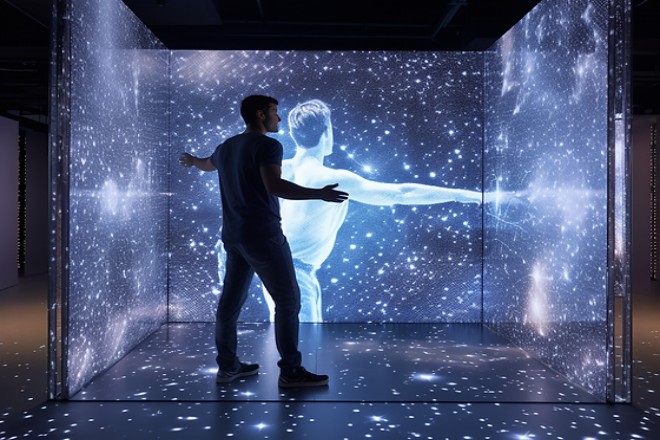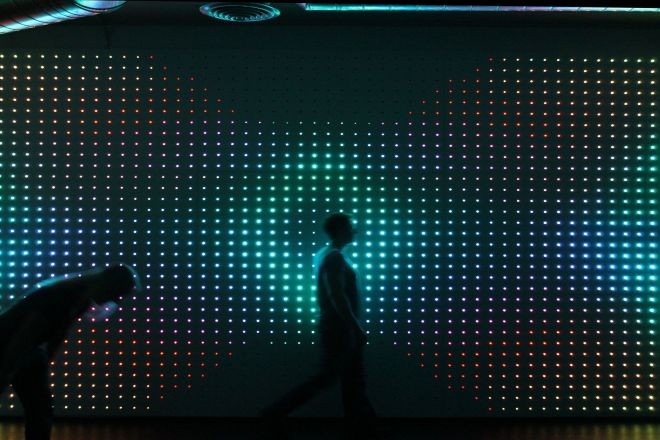소개

Have you ever seen interactive LED displays? For example: somatosensory interactive LED display wall, running LED display wall, etc.
In fact, LED displays are no longer satisfied with being able to play pictures and videos, and have begun to develop towards comprehensive interactivity. So why is this the case?
Reason 1: The promotion of LED display technology
1). Improvements in 명도, contrast, and 해결 make the picture more attractive
When you are outdoors in the sun, you want to see the content on an electronic screen clearly. If the screen is not bright enough and the contrast is not high, you may find it difficult. But now, the technology of LED displays has improved.
They have become brighter and have higher contrast, and you can see clearly even in strong light. More importantly, the improvement in resolution makes every detail on the screen vivid, just like you see it with your own eyes.
Such a display effect is simply too helpful for attracting the audience’s attention and enhancing the interactive experience.
When you play an interactive game or try on clothes in a virtual fitting room, high-resolution LED displays allow you to see more delicate and realistic pictures. In this way, you can immerse yourself in the game or fitting process more and enjoy the immersive feeling.
2). The emergence of new technologies, such as flexibility and transparency, makes the display screen more interesting
Have you ever thought about how interesting it would be if an electronic screen could be bent, folded, or even transparent? Now, these imaginations have become reality.
유연한 LED 디스플레이 can be bent like paper and can even be designed into various shapes, such as a curved wall or a round ceiling. Transparent LED displays are like a piece of transparent glass, but they can display various information.
These new technologies not only make LED displays more interesting and personalized but also bring new possibilities for interactive experience. For example, in a shopping mall, a transparent LED display can be embedded in the window to display the latest product information and attract customers’ attention.
At an art 전시회, a flexible LED display can be designed into various unique shapes to bring unprecedented visual enjoyment to the audience.
3). Intelligent control makes the display screen understand your heart better
Today’s LED displays are no longer just a tool for displaying information. They have become smarter and know how to interact with users. All this is due to the advancement of intelligent control technology.
The intelligent control system is like a brain. It can monitor the working status of the display screen, perceive changes in the surrounding environment, and even understand the user’s intentions. For example, when you approach an LED display screen, it will automatically light up and display a welcome message.
When you leave, it will automatically turn off to save energy. Such intelligent control not only makes the display screen more flexible and easy to manage but also greatly improves the quality of the interactive experience.
Moreover, the intelligent control system also supports multiple programming languages and interface protocols, which means that developers can easily integrate customized interactive content into the display screen.
In this way, you can see a variety of interesting and innovative interactive applications on the LED display screen, such as an interactive game that can change with your gestures or a smart home system that can adjust the display content according to your voice commands.
Reason 2: Changes in market demand and consumer preferences

1). Consumers want more “personal customization” experience
Today, consumers are no longer satisfied with the “one-size-fits-all” way of receiving information. They are more eager to get the feeling of being “tailor-made for me.” This trend is reflected in the demand for LED displays. That is, people are increasingly looking forward to interacting with the screen and getting a personalized experience from it.
Imagine that when you are walking on the street, you suddenly see a billboard that not only plays a video but also changes the content according to your reaction and even has a simple conversation with you. Isn’t this feeling of “knowing you very well” much more interesting than traditional one-way communication?
In the advertising industry, this interactive LED display has already made a big splash. Merchants have found that by making billboards “alive” and interacting with consumers, they can not only attract more eyeballs but also increase the conversion rate of advertisements.
예를 들어, 쇼핑몰, a billboard that can recognize your shopping preferences may recommend products that you are really interested in so that you are more likely to stop and even buy them.
In the entertainment field, interactive LED displays have become the highlight of major events. Whether it is a music festival, a concert, or an exhibition, these screens can interact with the audience in real-time, making the entire scene more lively.
2). In commercial displays, interaction makes everything more exciting
In commercial displays, interactivity is becoming more and more important. A static display, no matter how beautiful it is, may not be able to attract the audience’s attention for a long time. However, if interactive elements are added, the effect is completely different.
For example, at a car show, you may see a huge LED display that not only shows the exterior and interior of the car but also allows you to take a virtual test drive through the touch screen. This immersive experience gives you a deeper understanding of the car and makes you more likely to buy it.
Similarly, in electronic product experience stores, interactive LED displays have become a powerful assistant for displaying products. You can learn about the detailed parameters of the product through the screen, demonstrate its functions, and even talk to the AI assistant to get personalized usage suggestions.
These successful commercial display cases tell us that interaction can not only make the display more vivid and interesting but also enhance the audience’s sense of participation and experience, thereby promoting sales.
Reason 3: Promotion of innovative applications and cross-border cooperation
1). When art meets technology, LED displays become extraordinary
Have you ever thought that LED displays are not just a tool for playing advertisements but can also become an artist’s canvas or even a display window for technology? That’s right when LED displays are combined with art and technology, they become both beautiful and fun, just like being cast with magic.
In the field of art, LED displays are like a piece of magic cloth that changes color, on which artists can freely express their creativity. Through programming and interactive design, LED displays can change colors and patterns according to the audience’s actions, sounds, and even emotions, just like talking to you.
Such works not only make the audience feel novel but also allow them to understand the artist’s intentions and emotions more deeply.
In science and technology exhibitions, LED displays shine even more. It not only shows the cool functions of high-tech products, but also allows the audience to experience the charm of technology through interactive design.
For example, in some virtual reality experience areas, the LED display will adjust the picture in real-time according to your actions, making you feel like you are really in another world.
2). Cross-border cooperation makes LED displays ubiquitous
LED displays can now be seen not only in shopping malls and 박물관 but also in multiple industries, such as games, sports, and tourism. This cross-border cooperation not only makes the application scenarios of LED displays more extensive but also brings more possibilities for its interactivity.
In the game industry, LED displays have become a must-have artifact for game competitions. By connecting to the game console, the LED display can display the game screen in real-time, allowing players to immerse themselves in the virtual world of the game.
Moreover, it can also interact with players through touch, voice recognition, etc., making the game experience more real and exciting.
LED display screens also play an important role in sports events. Not only can they broadcast game images and statistics in real-time, but they can also allow the audience to participate in the game through interactive design.
For example, the audience can cheer for the team they support through mobile phone apps or on-site touch screens or participate in interactive games related to the game, making the entire game process more interesting and interactive.
In addition, LED display screens have also carried out cross-border cooperation with industries such as tourism and education. In tourist attractions, LED display screens can display scenic area guide information, interactive experience projects, etc..
In the field of education, it has become a powerful assistant for classroom teaching and distance education, helping students to better understand and master knowledge.
3). The Internet and the Internet of Things make LED display screens more “smart.”
You may have discovered that the current LED display screens are becoming more and more “smart.” Behind this, it is inseparable from the support of the Internet and the Internet of Things technology.
Through the Internet, we can remotely control the content, brightness, and other parameters of the LED display screen so that it can meet our needs anytime and anywhere.
Moreover, the Internet can also enable LED display screens to realize data interaction functions, such as collecting and analyzing audience behavior data, preference data, etc., so as to provide more accurate and personalized services.
The Internet of Things technology allows LED display screens to achieve seamless connection with other smart devices. For example, in smart homes, LED displays can work in conjunction with smart speakers, smart lights, and other devices to automatically adjust display content and interaction methods according to your needs and scene changes.
Such a design not only makes home life more convenient and comfortable but also further enhances the interactivity of LED displays.
4. What are the future prospects and challenges of LED displays?

1). Future trends in LED displays
1.1). New technological leaps
If the future LED display has extremely high clarity and the pixels are so small that they are almost invisible, it will be as natural as looking at the real world. This is the surprise brought to us by ultra-high definition and miniaturization technology.
This technology not only makes the picture clearer but also makes the display thinner and lighter. It can even be bent and folded, making it as easy to carry as a piece of paper.
Let’s talk about intelligence. The future LED display is no longer a cold display tool but a smart device that can “think.” They can understand your words, understand your gestures, and even change the content according to your expression. This intelligent interactive experience will make our lives more colorful.
1.2). Application areas continue to expand:
In addition to traditional advertising media, sports stadiums, and other fields, LED displays will also be widely used in emerging fields such as traffic guidance, 단계 performances, virtual reality, etc.
Especially in emerging fields such as e-sports, video conferencing, and 교육, the performance and quality requirements of display screens are getting higher and higher, which will promote the further development of the LED display industry.
With the continuous development of technologies such as XR (extended reality), naked eye 3D, and AR (augmented reality), the application of LED displays in stage performances, film and television production, etc., will be more extensive and in-depth.
2). 직면한 과제
2.1). Technical difficulties
Although the technology of LED display screens is constantly improving, it still faces some challenges. For example, how can we reduce energy consumption and costs while ensuring clarity?
How to make the display screen work stably in extreme environments? These are all problems that scientific researchers need to work hard to solve.
2.2). Competition in the market
As the LED display screen market continues to expand, competition is becoming more and more fierce. How do you stand out from many brands and become the first choice in the hearts of consumers?
This requires companies to work hard on quality, service, innovation, and other aspects to create a unique brand image.
3). Response strategies
3.1). Technological innovation
In the face of technical challenges, companies need to increase R&D investment and introduce and cultivate high-end technical talents.
At the same time, strengthen cooperation with universities and scientific research institutions to jointly overcome technical difficulties. Only by continuous innovation can we be invincible in the fierce market competition.
3.2). Differentiated competition
In the market competition, enterprises need to focus on differentiated competition. Through in-depth understanding of customer needs, customized solutions and high-quality service experience can be provided. This will not only meet the personalized needs of customers, but also enhance customer loyalty to the company.
결론
In summary, the significant enhancement of the interactivity of LED display screens is the result of the joint action of technological innovation, changes in market demand, and cross-border integration. Looking to the future, although there are many challenges, the opportunities are equally huge.
Only by continuous innovation and deepening cooperation can the interactive technology of LED display screens be promoted to a higher level and bring a more intelligent and rich interactive experience to human society.
마지막으로 LED 디스플레이 화면에 대해 더 알고 싶다면, 우리에게 연락해주세요.
